What is Giardia Intestinalis?
- Giardia intestinalis, also referred to as Giardia duodenalis or Giardia lamblia, is a flagellated protozoan parasite belonging to the genus Giardia. This microorganism primarily colonizes the small intestine, leading to a condition known as giardiasis, which is recognized as one of the most prevalent parasitic gastrointestinal infections worldwide. Giardiasis is characterized by a range of symptoms, including aqueous diarrhea, steatorrhea (fatty stools), nausea, abdominal discomfort, vomiting, and weight loss. Notably, one of the most severe outcomes of this infection is nutrient malabsorption, which can have particularly detrimental effects on children.
- The pathogenic mechanism of Giardia involves its attachment to the intestinal epithelium via an adhesive disc. This specialized structure allows the parasite to anchor firmly within the intestinal lumen, where it reproduces through a process known as binary fission. Importantly, Giardia remains localized to the small intestine and does not extend to other parts of the gastrointestinal tract. This localized infection can, however, lead to significant health complications, including anemia, stunted growth, and cognitive delays in affected children.
- Giardia trophozoites, the active form of the parasite, are anaerobic and derive their nutrients directly from the intestinal contents. The organism’s outer membrane provides it with the resilience to survive outside of its host environment, contributing to its ability to withstand certain disinfectants. When stained, Giardia exhibits a characteristic morphology that resembles a “smiley face,” aiding in its identification under the microscope.
- Transmission of Giardia occurs primarily through the ingestion of untreated drinking water, which is considered the most common route of infection. Other pathways include contaminated food, soil, and exposure to sewage, especially in areas with inadequate sanitation. This is particularly prevalent in many developing nations, where contaminated natural water sources are common due to agricultural practices and insufficient hygiene measures.
- Globally, Giardia infections are widespread, with an estimated 200 million cases reported by the World Health Organization (WHO). Among these, children aged 2 to 12 years are disproportionately affected, making giardiasis a significant public health concern in pediatric populations. In developed countries, giardiasis is recognized as a re-emerging infection, often associated with outbreaks in day-care centers and nurseries, where water contamination and low hygiene standards are common.
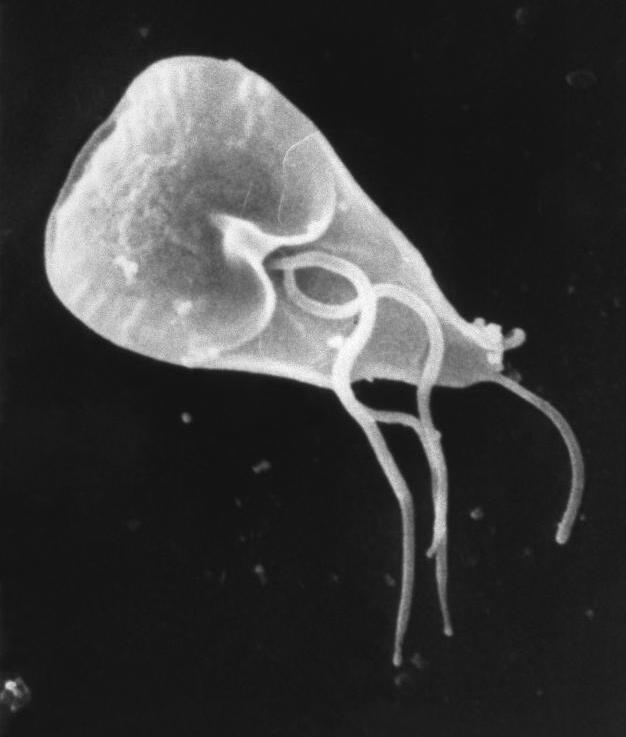
Classification of Giardia Intestinalis
| Domain: | Eukaryota |
| Phylum: | Metamonada |
| Order: | Diplomonadida |
| Family: | Hexamitidae |
| Genus: | Giardia |
| Species: | G. duodenalis |
History and Distribution of Giardia Intestinalis
Giardia intestinalis has a long and significant history as one of the earliest recognized protozoan parasites affecting humans. Its study has evolved over the centuries, revealing important aspects of its distribution and impact on public health.
- The first observation of Giardia intestinalis occurred in 1681 by the Dutch scientist Antonie van Leeuwenhoek, who identified the organism in his own fecal samples. This early discovery marked the beginning of understanding protozoan pathogens.
- The name “Giardia” is derived from Professor Alfred Giard of Paris, who contributed to the classification of the parasite, while “lamblia” honors Professor Václav Lamble of Prague, who provided a detailed description of its morphology and characteristics.
- Giardia intestinalis is recognized as the most prevalent protozoan pathogen in humans, with a global distribution that spans numerous geographic regions. It is particularly notorious for its role in causing giardiasis, a gastrointestinal infection marked by diarrhea and other digestive symptoms.
- The endemicity of Giardia is especially pronounced in areas where sanitation practices are inadequate. Regions within the tropics and subtropics are particularly susceptible to higher rates of infection due to poor water quality and hygiene.
- Travelers visiting these endemic regions frequently experience traveler’s diarrhea, which is often attributed to giardiasis. Contaminated drinking water is a primary route of transmission, highlighting the importance of clean water access and sanitation.
- In developed countries, giardiasis is re-emerging as a public health concern, particularly in child care settings and areas where water contamination and low hygiene practices are prevalent. This resurgence reflects the need for ongoing vigilance and effective measures to mitigate the spread of the parasite.
Habitat of Giardia Intestinalis
Giardia intestinalis, commonly known as Giardia lamblia, is a flagellated protozoan parasite that plays a significant role in human gastrointestinal infections. Its habitat extends beyond the human body, encompassing various environmental and biological niches. Understanding these habitats is crucial for comprehending how this organism thrives and spreads.
- Intestinal Tract: The primary habitat of Giardia intestinalis is the small intestine, particularly the duodenum and upper jejunum. Here, the parasite utilizes its adhesive disk to attach to the intestinal wall, allowing it to evade peristaltic movements and reside in a nutrient-rich environment. This location is critical for its reproduction and survival within the host.
- Water Sources: Outside the host, Giardia intestinalis can survive in freshwater ecosystems such as lakes, rivers, and streams. It forms cysts, which are resilient structures that can withstand various environmental stressors, including temperature fluctuations and desiccation. These cysts can persist in water for several weeks to months, contributing to the transmission of the parasite to new hosts.
- Soil Contamination: The presence of Giardia intestinalis is not limited to water; it can also inhabit contaminated soil. This is particularly prevalent in areas subjected to significant animal fecal contamination. Soil can act as a reservoir for the cysts, further facilitating the spread of the parasite when humans or animals come into contact with contaminated soil.
- Contaminated Food: Giardia intestinalis can contaminate food, particularly when food items are washed or prepared using water that contains the cysts. Additionally, fruits and vegetables grown in contaminated soil can also become vehicles for the parasite, making it imperative to ensure proper hygiene practices in food handling.
- Diverse Hosts: This protozoan is not exclusive to humans; it can infect various mammalian hosts, including livestock, pets, and wildlife. The transmission typically occurs through the fecal-oral route, highlighting the importance of sanitation and hygiene. Infection can result from consuming contaminated water or food, as well as through direct contact with feces from infected individuals or animals.
- Transmission Dynamics: The lifecycle of Giardia intestinalis is crucial to its habitat. Once ingested, the cysts transform into trophozoites in the intestine, leading to the potential for symptomatic infections characterized by diarrhea and gastrointestinal distress. The shedding of cysts in feces perpetuates the cycle, allowing the organism to spread rapidly within populations.
- Environmental Persistence: The ability of Giardia intestinalis to endure in various environments enhances its potential for transmission. Its cysts can survive extreme environmental conditions, which underscores the need for public health initiatives aimed at reducing contamination in water sources, soil, and food.
Morphology of Giardia Intestinalis
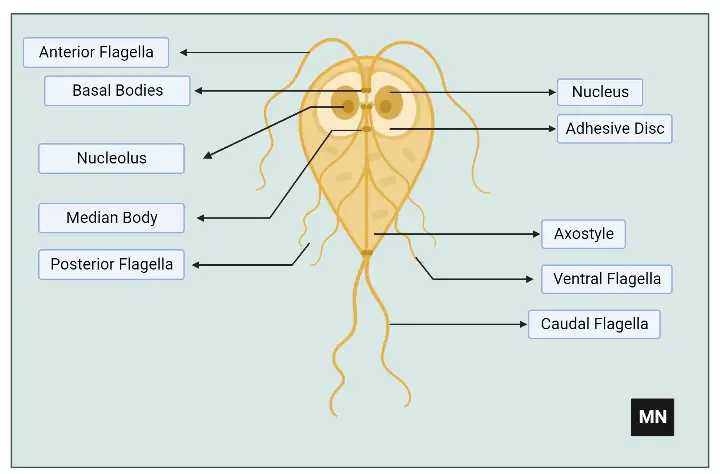
Giardia intestinalis, a protozoan parasite responsible for giardiasis, exists in two main forms throughout its lifecycle: the trophozoite and the cyst. Each form has distinct structural characteristics that allow it to function effectively within its environment, whether it is infecting a host or surviving outside it.
- Trophozoite:
- The trophozoite is the active, feeding form of Giardia intestinalis, primarily found in the host’s small intestine.
- It has a tennis racket-like or pear-shaped body, with a broad, rounded anterior end and a tapered posterior end.
- It typically measures 9-21 µm in length and 5-15 µm in width, with the dorsal surface convex and the ventral surface concave, housing a sucking disc. The sucking disc allows the trophozoite to attach to the intestinal mucosa of the host, facilitating its colonization.
- The organism is bilaterally symmetrical, meaning that its internal structures are paired. It contains:
- Two nuclei, each with a large central karyosome, giving the parasite a characteristic “face-like” appearance in stained preparations.
- Four pairs of flagella, arising from a structure called the blepharoplast. These flagella provide motility to the trophozoite, contributing to its characteristic falling leaf-like motion.
- Two sausage-shaped median bodies, which are unique to Giardia and are situated posterior to the sucking disc.
- Two axostyles, running along the midline of the body, providing structural support.
- The cytoplasm of the trophozoite is uniform and finely granulated, supporting various metabolic activities. The organism’s motility, which involves a slow oscillation resembling a falling leaf, aids in navigating the intestinal environment.
- Cyst:
- The cyst represents the infective, non-motile form of Giardia intestinalis, allowing the parasite to survive outside the host in harsh environmental conditions.
- The cyst is oval or ellipsoidal in shape, measuring 8-12 µm in length and 7-10 µm in breadth.
- It is surrounded by a thick hyaline cyst wall, which provides protection against desiccation and other environmental factors. This allows the cyst to remain viable for extended periods in water, soil, or on surfaces.
- Internally, the cyst contains four nuclei, which are grouped at one end of the cyst. In immature cysts, only two nuclei may be present.
- The cytoplasm is finely granulated, and the axostyle runs diagonally across the cyst, dividing the cytoplasm into distinct regions.
- Remnants of the flagella and sucking disc may be visible inside the cytoplasm of younger cysts, indicating its transition from trophozoite form.
- The cyst is the form that initiates infection once ingested by a host, excysting in the small intestine to release trophozoites.
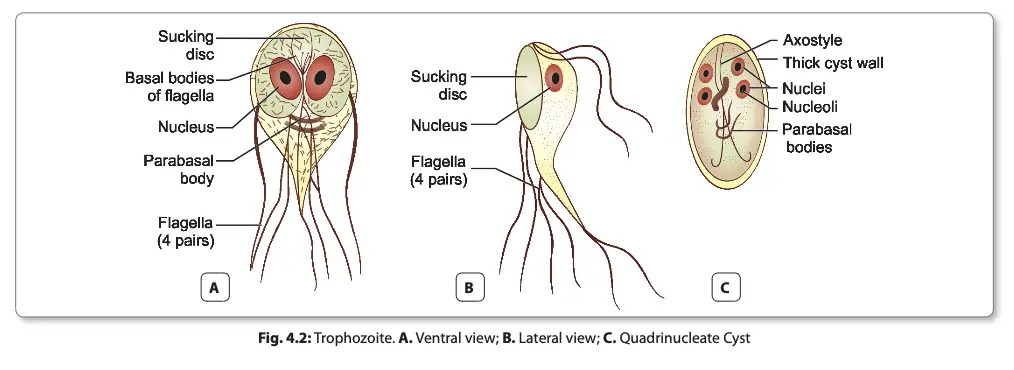
Life cycle of Giardia Intestinalis
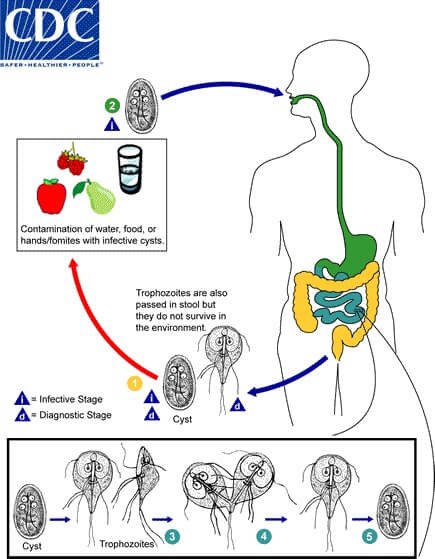
The life cycle of Giardia intestinalis, a protozoan parasite that causes giardiasis, takes place within a single host, primarily humans. The cycle involves two distinct stages: the trophozoite, which actively feeds and reproduces, and the cyst, which serves as the infective and environmentally resistant form. Understanding each step of the life cycle is crucial for comprehending how Giardia intestinalis spreads and causes infection.
- Infective Form:
- The mature cyst is the infective stage of Giardia intestinalis. These cysts are passed in the feces of infected individuals and can survive in the environment, particularly in water or food, for extended periods.
- Mode of Transmission:
- Humans acquire the infection primarily by ingestion of cysts through contaminated water or food.
- Person-to-person transmission can occur, especially in settings involving close contact, such as among children, male homosexuals, or mentally ill individuals.
- Certain conditions, such as blood group A, achlorhydria (absence of stomach acid), malnutrition, chronic pancreatitis, and immune system defects like IgA deficiency or hypogammaglobulinemia, increase susceptibility to infection.
- Excystation:
- Once ingested, the cysts pass through the stomach and reach the small intestine. Within 30 minutes of ingestion, excystation occurs.
- The cysts hatch, releasing two trophozoites. These trophozoites are the motile and feeding stage of the parasite.
- Colonization:
- The trophozoites multiply by binary fission and colonize the duodenum and the upper part of the jejunum.
- They attach to the intestinal wall using their sucking disc and feed by pinocytosis, absorbing nutrients from the host’s intestinal lining.
- Encystation:
- Under unfavorable conditions, such as changes in the intestinal environment, encystation occurs. This process typically takes place in the colon, where trophozoites transform back into the cyst form.
- The cysts are then excreted in the feces, completing the cycle. These cysts are highly resistant and can remain viable in the environment, particularly in soil or water, for several weeks.
- Excretion and Environmental Survival:
- The cysts are passed in the stool, with some infections shedding up to 200,000 cysts per gram of feces.
- The infective dose is relatively low, requiring only 10-100 cysts to initiate an infection, making Giardia intestinalis highly contagious.
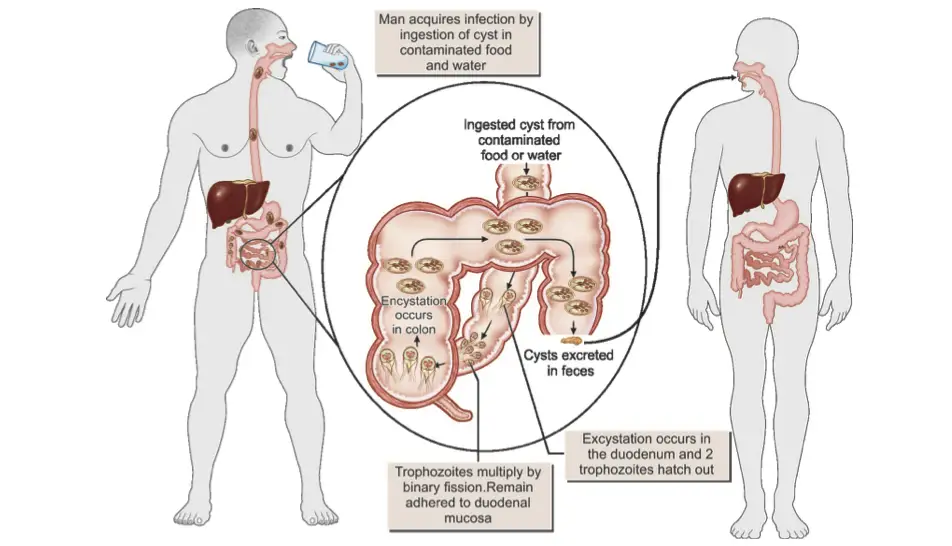
Pathogenicity and Clinical Features of Giardia Intestinalis
Giardia intestinalis (also known as Giardia lamblia) is a protozoan parasite that primarily infects the small intestine. While it does not invade the tissues of its host, its presence and activity in the intestinal lumen can cause significant clinical symptoms and pathology. Understanding the pathogenicity and clinical features of Giardia intestinalis is crucial in diagnosing and managing giardiasis, the condition it causes.
- Pathogenicity:
- Giardia intestinalis adheres to the duodenal and jejunal mucosa using its sucking disc. It remains attached to the intestinal epithelium but does not penetrate the tissue.
- Its attachment to the intestinal surface can lead to structural changes, including:
- Abnormalities in villous architecture, where the intestinal villi (small finger-like projections that aid in nutrient absorption) become damaged.
- Cell apoptosis (programmed cell death) occurs, affecting the epithelial cells of the intestine.
- Increased lymphatic infiltration of the lamina propria, which refers to an influx of immune cells into the deeper layers of the intestinal wall in response to the infection.
- The variant-specific surface proteins (VSSP) on the surface of Giardia play a crucial role in the parasite’s ability to cause infection and evade the host’s immune system. These proteins allow the parasite to adhere to the intestinal epithelium and survive in the hostile environment of the gastrointestinal tract.
- Clinical Features:
- The infection caused by Giardia intestinalis is often asymptomatic, meaning that many individuals carry the parasite without showing any symptoms.
- In cases where symptoms do manifest, they typically include:
- Mucus diarrhea: The stool is characterized by excessive mucus and fat (known as steatorrhea), but does not contain blood, distinguishing it from other forms of infectious diarrhea.
- Fat malabsorption: The parasite interferes with the body’s ability to absorb fat, leading to greasy and foul-smelling stools.
- Dull epigastric pain: Pain or discomfort is often felt in the upper abdominal region.
- Flatulence: Excessive gas production is a common symptom.
- In children, the infection can lead to more severe consequences, such as:
- Chronic diarrhea, which persists over an extended period.
- Malabsorption of nutrients, including fats, vitamin A, protein, and sugars (e.g., xylose and disaccharides), leading to deficiencies.
- Weight loss and a condition resembling sprue-like syndrome, where the intestinal lining is damaged, preventing nutrient absorption.
- Occasionally, the parasite may colonize the gall bladder, leading to conditions such as:
- Biliary colic, which involves severe pain due to gall bladder inflammation.
- Jaundice, caused by obstruction of bile flow.
- Incubation Period:
- The incubation period for Giardia intestinalis infection is variable, but it is typically about two weeks from the time of ingestion of the cysts to the onset of symptoms.
Clinical manifestation of Giardia Intestinalis
Giardia lamblia infection, also known as giardiasis, is a common parasitic infection worldwide. The incubation period of the infection can range from 1-3 weeks, after which the clinical manifestation varies depending on the severity of the infection. It is important to note that a majority of the infections are asymptomatic, especially in adults.
- Acute giardiasis: However, in symptomatic infections, acute giardiasis is characterized by acute watery diarrhea, abdominal cramp, bloating, and flatulence, with occasional symptoms of nausea, vomiting, fever, rashes, or constipation. Pus, blood, and mucus are not seen in the stool. The condition usually lasts for 5-7 days.
- Chronic giardiasis: In chronic giardiasis, symptoms include chronic diarrhea with malabsorption of fat (steatorrhoea) and malabsorption of vitamin A, protein, and D-xylose, resulting in weight loss, malaise, and anorexia. Children may show signs of protuberance of the abdomen, spindly extremities, and stunted growth. Chronic giardiasis can last for several weeks, and extra-intestinal complications such as urticarial and reactive arthritis are rare.
- Complication: In adults, chronic giardiasis can lead to malabsorption syndrome and weight loss, while in children, it can cause growth retardation and delayed milestones achievements. However, it is important to note that giardiasis is a self-limited disease, and progression to the chronic state is only seen in 5% of infected people. Death is rare.
Laboratory diagnosis of Giardia Intestinalis
Laboratory diagnosis of Giardia intestinalis is essential for confirming giardiasis in symptomatic and asymptomatic individuals. Various diagnostic methods can detect both the cysts and trophozoites of the parasite, using fecal samples, antigen detection techniques, and molecular methods. Below are the key laboratory approaches used in diagnosing Giardia intestinalis:
- Stool Examination:
- The primary method for diagnosing giardiasis is the identification of cysts in formed stools or trophozoites in diarrheal stools.
- Macroscopic examination of fecal specimens may reveal pale-colored, fatty stools with an offensive odor. These stools are often fatty and tend to float due to malabsorption.
- Microscopic examination is performed using saline and iodine wet preparations to detect cysts and trophozoites. It is important to examine multiple stool samples because parasites may be shed intermittently.
- Concentration techniques, such as formalin-ether sedimentation or zinc acetate flotation, are employed to enhance the detection of cysts, especially in asymptomatic carriers where only cysts are present.
- Enterotest (String Test):
- This test involves swallowing a small weighted gelatin capsule containing a coiled thread. The free end of the thread is taped to the patient’s cheek.
- After the capsule reaches the duodenum (usually after two hours), the thread is withdrawn, placed in saline, and shaken mechanically. The centrifuged deposit is then examined for the presence of Giardia.
- Although effective in obtaining duodenal samples, the enterotest is rarely used due to its high cost and invasive nature.
- Antigen Detection:
- Enzyme-linked immunosorbent assay (ELISA) and immunochromatographic strip tests are highly sensitive and specific for detecting Giardia antigens in stool.
- ELISA tests can detect Giardia-specific antigen 65 (GSA 65), which confirms active infection.
- The sensitivity of ELISA is approximately 95%, and its specificity reaches 100% compared to conventional microscopy.
- These antigen detection methods are particularly useful for quantifying cysts and are often applied in epidemiological studies and control programs.
- Enzyme-linked immunosorbent assay (ELISA) and immunochromatographic strip tests are highly sensitive and specific for detecting Giardia antigens in stool.
- Antibody Detection:
- Indirect immunofluorescent tests (IIF) and ELISA are used to detect antibodies against Giardia in serum. However, these tests are not typically used for routine diagnosis because:
- They cannot distinguish between recent and past infections.
- They also have limitations in sensitivity and specificity.
- Antibody detection is primarily valuable in epidemiological and pathophysiological studies, rather than routine clinical diagnosis.
- Indirect immunofluorescent tests (IIF) and ELISA are used to detect antibodies against Giardia in serum. However, these tests are not typically used for routine diagnosis because:
- Molecular Methods:
- Polymerase chain reaction (PCR) and DNA probes are increasingly used to detect Giardia DNA in stool samples.
- These techniques allow for the amplification and identification of parasitic genomes, offering high precision in diagnosis.
- Molecular methods are particularly helpful in identifying subtypes of Giardia and understanding the genetic diversity of the parasite in different populations.
- Polymerase chain reaction (PCR) and DNA probes are increasingly used to detect Giardia DNA in stool samples.
Treatment of Giardia Intestinalis
The treatment of Giardia intestinalis aims to eliminate the parasite from the body, resolve symptoms, and prevent transmission. Effective treatment options include several antimicrobial agents that target the trophozoites in the intestine. Below is an overview of the treatment strategies, commonly used medications, and considerations for different patient groups:
- Metronidazole:
- Dosage: 250 mg, taken three times daily for 5–7 days.
- Effectiveness: Metronidazole has a cure rate of over 90% for giardiasis.
- Mode of Action: It disrupts the DNA of the parasite, inhibiting its ability to replicate.
- Consideration: Although effective, metronidazole may cause side effects such as nausea and a metallic taste in the mouth.
- Tinidazole:
- Dosage: A single dose of 2 g.
- Effectiveness: Tinidazole is more effective than metronidazole, with similar mechanisms of action.
- Advantages: Due to its single-dose regimen, tinidazole is more convenient for patients and has fewer gastrointestinal side effects.
- Furazolidone:
- Preferred for Children: This medication is often favored for pediatric patients due to its safety profile and fewer adverse effects compared to other drugs.
- Mechanism: It inhibits the growth of the parasite by interfering with its enzyme systems.
- Dosage: Typically administered over a few days, the dosage depends on the patient’s age and weight.
- Nitazoxanide:
- Alternative for Children: Another pediatric-friendly option, nitazoxanide is well-tolerated with minimal side effects.
- Dosage: Usually administered twice daily for three days.
- Function: It interferes with energy production in the trophozoites, leading to their death.
- Paromomycin:
- Use in Pregnancy: Paromomycin, an oral aminoglycoside, is considered safe for treating symptomatic pregnant women because it is not absorbed systemically and remains within the gastrointestinal tract.
- Dosage: Administered in divided doses, typically for a duration of 5–10 days.
- Considerations: Although safe for pregnancy, paromomycin may be less effective than other systemic treatments.
- Combination Therapy:
- In certain cases, combination therapies may be employed to improve treatment efficacy, especially in cases of drug resistance or recurrent infections.
Prophylaxis of Giardia Intestinalis
The prevention of Giardia intestinalis infection, also known as giardiasis, focuses on interrupting the parasite’s transmission through a combination of personal hygiene, environmental controls, and safe food and water practices. Effective prophylactic measures are vital in reducing the incidence of infection, particularly in areas with poor sanitation or in populations at higher risk of exposure. Below are key preventive strategies:
- Proper Disposal of Wastewater and Feces:
- Ensuring the safe and hygienic disposal of human waste is critical in reducing the environmental contamination of water sources, as Giardia cysts are commonly spread through fecal matter. This includes the use of properly maintained sanitation facilities and sewage treatment systems.
- Personal Hygiene Practices:
- Hand-washing: Regular hand-washing, particularly before meals and after using the restroom, is one of the simplest and most effective methods of preventing the ingestion of Giardia cysts. This practice is especially important in settings such as daycares, schools, and healthcare facilities where close contact with infected individuals may occur.
- Handling of Diapers: Proper disposal of diapers and careful hand-washing afterward is essential to prevent the spread of the parasite, particularly in young children who may unknowingly spread the infection.
- Prevention of Food and Water Contamination:
- Safe Food Handling: Avoiding the consumption of food that may have come into contact with contaminated water or soil is essential. Washing fruits and vegetables thoroughly and practicing safe food preparation techniques are important steps in preventing infection.
- Water Treatment: Giardia cysts are highly resistant to standard chlorination practices used in community water supplies. Therefore, boiling water is an effective method for inactivating the cysts, ensuring the water is safe to drink.
- Filtration: Membrane filtration systems, which can remove small particles, including Giardia cysts, are also necessary in areas where the water supply may be compromised. Filters with a pore size of 1 micron or smaller are recommended for effective cyst removal.
FAQ
What is Giardia duodenalis?
Giardia duodenalis is a unicellular protozoan parasite that causes giardiasis, an intestinal infection that can lead to diarrhea, abdominal pain, and other gastrointestinal symptoms.
How is Giardia duodenalis transmitted?
The parasite is transmitted through the ingestion of cysts in contaminated water, food, or surfaces. Person-to-person transmission can also occur through the fecal-oral route.
What are the symptoms of Giardia duodenalis infection?
The symptoms of Giardia duodenalis infection can vary from mild to severe and include diarrhea, abdominal cramps, bloating, gas, nausea, and weight loss.
How is Giardia duodenalis diagnosed?
Giardia duodenalis can be diagnosed through a stool examination for the presence of cysts or trophozoites. Alternatively, antigen detection tests and nucleic acid amplification tests can also be used.
What is the treatment for Giardia duodenalis infection?
The treatment for Giardia duodenalis infection usually involves a course of antibiotics, such as metronidazole or tinidazole. Anti-parasitic drugs like nitazoxanide, furazolidone, and paromomycin are also effective in treating the infection.
Can Giardia duodenalis infection be prevented?
Giardia duodenalis infection can be prevented by practicing good hygiene, such as washing hands with soap and water before eating, avoiding contaminated food and water sources, and treating water with chlorine or other disinfectants.
Is Giardia duodenalis infection contagious?
Yes, Giardia duodenalis infection can be contagious and is spread through the fecal-oral route. Person-to-person transmission can occur through close contact with infected individuals or through contact with contaminated surfaces.
How long does it take for Giardia duodenalis symptoms to appear after infection?
Symptoms of Giardia duodenalis infection usually appear 1 to 3 weeks after exposure to the parasite.
Can Giardia duodenalis infection recur after treatment?
Yes, Giardia duodenalis infection can recur after treatment, particularly in individuals who have weakened immune systems or who are exposed to contaminated sources of water or food.
Can animals transmit Giardia duodenalis to humans?
Yes, animals can transmit Giardia duodenalis to humans, particularly through contact with contaminated fecal matter. Common sources of infection include dogs and cats, as well as livestock and wildlife.
- Adam RD. Biology of Giardia lamblia. Clin Microbiol Rev. 2001 Jul;14(3):447-75. doi: 10.1128/CMR.14.3.447-475.2001. PMID: 11432808; PMCID: PMC88984.
- Robertson, L. J. (2014). Giardia duodenalis. Microbiology of Waterborne Diseases, 375–405. doi:10.1016/b978-0-12-415846-7.00019-6
- Vivancos , V., Gonzalez-Alvarez , I., Bermejo, M., & Gonzalez-Alvarez, M. (2018). Giardiasis: characteristics, pathogenesis and new insights about treatment. Current Topics in Medicinal Chemistry, 18. doi:10.2174/156802661866618100
- Lalle, M., & Fiorillo, A. (2019). The protein 14-3-3: A functionally versatile molecule in Giardia duodenalis. Giardia and Giardiasis, Part A, 51–103. doi:10.1016/bs.apar.2019.08.002
- Jex, A. R., Svärd, S., Hagen, K. D., Starcevich, H., Emery, S. J., Balan, B., … Dawson, S. C. (2020). Recent advances in functional research in Giardia intestinalis. Advances in Parasitology. doi:10.1016/bs.apar.2019.12.002
- Robertson, L. J. (2014). Giardia duodenalis. Encyclopedia of Food Microbiology, 94–98. doi:10.1016/b978-0-12-384730-0.00147-6
- https://www.biologydiscussion.com/protozoa-2/structure-of-giardia-lamblia-with-diagram-zoology/49278
- https://www.onlinebiologynotes.com/giardia-lamblia-morphology-life-cycle-pathogenesis-clinical-manifestation-lab-diagnosis-and-treatment/
- https://microbeonline.com/giardia-lamblia-life-cycle-diseases-and-laboratory-diagnosis/
- https://www.cell.com/trends/parasitology/fulltext/S1471-4922(22)00002-2
- https://www.cdc.gov/dpdx/giardiasis/index.html
- https://en.wikipedia.org/wiki/Giardia_duodenalis
- https://journals.asm.org/doi/10.1128/CMR.00024-19
- https://journals.asm.org/doi/10.1128/CMR.13.1.35
- Text Highlighting: Select any text in the post content to highlight it
- Text Annotation: Select text and add comments with annotations
- Comment Management: Edit or delete your own comments
- Highlight Management: Remove your own highlights
How to use: Simply select any text in the post content above, and you'll see annotation options. Login here or create an account to get started.